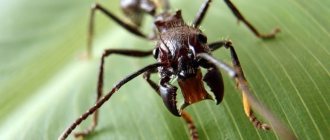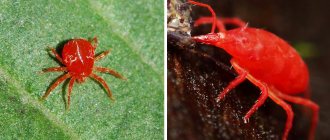When asked what a hornet is, they usually answer that it is a huge wasp. The answer is both correct and wrong. There are 23 species of very large wasps in nature, commonly called hornets, although their correct name is hornet wasps. The international common name for wasps and hornets is Vespa Linnaeus. Initially, common wasps were grouped with wasps into one genus, but since the 19th the insects have been divided into the hornet wasp Vespa and the common wasp Vespula ("little wasp"). The wasp family is quite numerous and also includes Scolia, which is equal to the world's largest giant Asian hornet.
Habitats
Hornets are found in the Northern Hemisphere. The real homeland of all these species is Eurasia. Of all the varieties of hornets, only one species has settled in North America - the European one. But it was accidentally introduced by settlers and did not advance further than the eastern part of the North American continent.
Interesting!
The same name in America is often used to refer to the large spotted wasp.
Since scolias, wasps and hornets are representatives of the same order, people often confuse them with each other. It is unlikely that anyone will seriously study a brightly colored insect that has flown into a window. But in some areas, these stinging individuals are a protected species, so it is useful to be able to distinguish a wasp or scolia from a hornet.
Comparative characteristics of the European hornet and wasp
Hornet and wasp
Looking at the description and photo of a hornet, it is difficult to immediately understand how it differs from a wasp. Especially if there is nothing to compare with. But if you look at a close-up photo of a hornet in comparison with the same photo of a wasp, the differences become clear, although the European hornet is very similar to a paper wasp.
The common hornet is the smallest insect of all representatives of this genus. The length of the body of the uterus of the European hornet is 2.5-3.5 cm. Working females and males are even smaller: 1.8-2.2 cm. That is, the size of a working individual is almost equal to the size of a wasp, but the body is much more powerful, and the abdomen sits completely short jumper, almost touching the chest.
The male differs from the female in the larger number of segments on the antennae (13 instead of 12), the number of segments on the abdomen (7 instead of 6) and the absence of a sting. In a killed insect, all this can be counted and checked to make sure that it was not the queen who was looking for a place for a nest.
The hornet's head is large, round, with a wide nape. In the wasp, the back of the head narrows as it transitions to the neck. The wings are small and, when at rest, are located along the body. The head and chest are brown (black in the wasp). The abdomen is brown below. On top it has alternating yellow and black stripes.
This type of hornet lives in families, which can include a significant number of working individuals. The insects are relatively peaceful; if you do not get closer than 0.5 m to the nest, they will not bother you. Otherwise they attack together.
Interesting!
Contrary to myths, the hornet has only one sting. This is a modified ovipositor that serves to kill prey. Therefore, the reusable instrument is smooth and does not get stuck in the skin.
The bite of a hornet of this species is not very dangerous to humans: the bite site is very itchy and swells if you scratch it. The tissue remains in this state for a week. Then everything goes away. The described scenario is only true for people who are not allergic to insect bites.
Review
Some of these flew into our kitchen, but we thought they were huge wasps. They flew to the smell of jam. Nothing, rolled up newspapers had an effect on them too. If you clap harder.
Vladimir, Voronezh
On a note!
The Ural hornet species does not exist, but the European one is distributed throughout Eurasia, including the Southern Urals. The southern edge of the Ural ridge almost coincides with the Russian-Kazakh border; in this area there is a high probability of the appearance of another species - the eastern hornet. Therefore, with a high degree of probability, a common (European) or eastern hornet is hidden under the local name.
But among the species of hornets in Russia there is one that is truly dangerous for people and livestock. This is the Asian giant murder hornet.
General information about hornets
Hornet is an insect related to wasps. The genus of hornets is classified as a widespread family of true (paper, social) wasps, among which its representatives are the largest (up to 5.5 cm in length).
In Latin, the genus of hornets is called Vespa, which means “wasp”.
The hornets' habitat is mainly in the Northern Hemisphere (Europe, Asia, North America, North Africa).
Table: classification of hornets
| Kingdom | Animals |
| Type | Arthropods |
| Class | Insects |
| Squad | Hymenoptera |
| Family | Real wasps |
| Genus | Hornets |
Structure and description
The average size of a hornet is 180–350 millimeters in length. The head is black, yellow, orange or red-brown - often the insect is distinguished by its reddish tint. The jaws are black, brown or orange-yellow. The coloring of the body, as a rule, is similar to that of a wasp - alternating black and yellow or reddish stripes, but usually they are not so contrasting. There are exceptions, for example, the variable hornet, painted exclusively in dark colors.
In general, the structure of the hornet is similar to the structure of other wasps:
- the body is divided into head, chest and abdomen;
- on the head there are two compound and three simple eyes;
The complex compound eyes of a hornet resemble sunglasses - there are two pairs of wings;
- the place where the chest meets the abdomen is narrow (“wasp waist”);
- at the posterior end of the abdomen there is an ovipositor (also known as a sting), which is retracted in a calm state.
The ovipositor of hornets, like that of other wasps, is smooth. Therefore, they can sting several times, unlike bees, which cannot get the barbed stinger back.
In addition to their size, hornets differ from other wasps in their wider crown (the part of the head located behind the eyes). In addition, their abdomen is rounded at the front.
Features of the life of a hornet
Hornets have a complex social organization with its own hierarchy. Insects of one colony (from several hundred to several thousand individuals) are divided into castes:
- queen - lays eggs, lives, as a rule, a year, but maybe more if it survives the winter;
- males - fertilize the uterus, live for several weeks - quickly die after fertilization;
- female workers - build a nest, get food, live for about a month.
Photo gallery: common hornets from different castes
The queen hornet is larger than all other individuals
Most of the workers are in the nest
Males are smaller in size
Reproduction
Working females are infertile because the queen secretes special pheromones that block the ability of “rivals” to reproduce. But around the beginning of autumn, the queen hornet lays eggs, from which females will emerge capable of bearing offspring. Males also appear at the end of summer. They mate with future queens. With the onset of cold weather, the hive dies, only fertilized females remain alive, looking for shelter for the winter. In the spring, the young queen chooses a place for a new colony, where she begins to build honeycombs.
Hornet development cycle:
- Each cell of the honeycomb built by the queen will contain an egg.
A new generation of workers will emerge from the eggs laid by the queen. - After about a week, larvae 1–2 mm in size will emerge from the eggs.
- After two weeks, the larvae become pupae.
- After another 14 days, an adult emerges from the pupa - a working hornet.
Nests
Hornets' homes are multi-tiered (up to 500 tiers). Insects hang nests in hollows, abandoned birdhouses, dry bushes, in attics and under the roofs of houses, in caves and simply on tree branches. Hornets' houses are large - they can reach 70 cm in height and exceed 40 cm in width.
Like their wasp relatives, hornets hang their nests at heights
The material used to build nests and the method of its production resembles paper. Hornets chew bark or wood well, adding their sticky saliva to it. The nest is built from the layers of the resulting mass. When the material dries, it becomes very similar to wrapping paper.
Hornets' nests look like they're made of paper
Some species of hornets build underground nests. And there are also those that take over other people’s nests, killing the host queen.
Nutrition
Hornets are omnivores. Adults consume plant foods and are especially fond of sweets: fruits, honey, nectar. They hunt various insects: flies, grasshoppers, caterpillars, wasps, aphids, ticks and others. They feed their larvae with animal food, after grinding it with their jaws to a liquid state. Dead insects, as well as human food waste (meat, fish), can be used to feed offspring.
Hornets sleep very rarely and work even at night.
Giant Asian
The Asian giant murder hornet
lives in warm regions, and a Russian tourist may encounter it when traveling to China, Vietnam, Taiwan or Japan. But as a result of global warming, this species has reached the Russian Far East. This means that you can meet him without leaving the country.
The size of the hornet reaches 5 cm with a wingspan of up to 7.5 cm. The insect has a very large head. In proportion to the body, it is significantly larger than other representatives of this genus. The painting is done strictly in black and yellow tones. The photo shows what an Asian hornet looks like. It has a completely yellow head, black chest and striped abdomen. Yellow is very dark and borders on orange.
Interesting!
In Japan, the Asian giant is called the “sparrow bee.” Due to the size of the insect, the poison of this huge wasp is much more dangerous. Especially if several bites are inflicted at once. In Japan, 40 people a year die from sparrows.
Common and black hornets coexist with the Asian giant. If an ordinary one behaves “decently,” then a black one can do harm.
Starting a new family
In the spring, with the onset of warmth, the young female awakens from winter torpor and actively feeds for several days to restore strength.
It is also useful to read: Giant Asian hornet Vespa Mandarinia
The basis of its diet during this period consists of other insects, and sometimes berries and fruits thawed from under the snow.
At the same time, the future queen is looking for a convenient place to place the nest: it can be either just a strong branch, or a hollow, a crack in a rock or a hole in a sandy slope. The queen collects soft young bark from tree branches, chews it and builds the first combs, into which she immediately lays eggs.
In parallel, the young queen continues to create a new hornet nest, building on the primary structure. Thanks to the strength of the founding queen alone, the home of insects can sometimes reach the size of half a football.
When the first larvae hatch from the eggs, the queen herself catches insects for them and feeds her future helpers. When the first working individuals appear, the queen hornet practically stops flying, all her activity comes down to laying eggs. Insect workers take on all the responsibilities of obtaining food for the larvae and the queen, caring for them, and also building new honeycombs.
This is interesting
Among all 23 species of hornets, there is one that is radically different from its relatives - the black hornet. Its females exhibit so-called nest parasitism: they do not build nests and do not feed the first larvae. All spring, the females simply feed carefreely, and at the beginning of summer they find a family of common hornets, penetrate their nest, kill the queen and, disguised with pheromones, impersonate her. Of course, such a “trick” is very dangerous, because working individuals can kill the alien even before she gets to their uterus. However, such a seizure of power is often successful, and the workers look after the new queen as diligently as they looked after the previous one. Of course, new black hornets will emerge from the eggs she lays, which will gradually replace the old owners of the nest.
Dybovsky's Hornet
Dybovsky's Hornet
The second name of this species is “black hornet”. The coloring resembles a strange bee with a black belly and red-brown head and chest. There are no yellow spots on the body. It is rare because it leads a parasitic lifestyle. The female Dybowski hornet takes over the nests of smaller relatives, forcing workers to take care of her offspring. This species does not need a “family” to reproduce; queens and males are sufficient.
The bite is stronger than that of the European species, but weaker than that of the Asian species. The poison is intended only to kill insects, so the consequences for humans may differ from the reaction to the bite of other types of wasps.
On a note!
Another black hornet wasp, native to China, was introduced to France. Vespa velutina is not dangerous to beekeeping and is completely black in color. Only her paws and two thin stripes on her abdomen are yellow.
Eastern wasp
Eastern hornet
The more correct name is “eastern hornet”. This is the only insect among the large wasps that can survive in very dry climates. Habitats are dry and hot. You can encounter it when traveling to Southern Europe, North Africa, the islands of the Mediterranean Sea, and the semi-dry subtropics of Asia (former Central Asian republics). In Russia it is found on the southern borders of the state.
- The species is not large. The maximum size of the uterus is 3 cm.
- The color is slightly similar to the European hornet, but the black color is “replaced” with red-brown. The upper third of the abdomen and the tip are also red-brown in color. Between them there is a yellow stripe. Because of this brown color, this type of large wasp has a third name: “red hornet.”
The species is very active and causes significant damage to beekeeping farms.
On a note!
The blue hornet does not exist in nature. This is the mistaken name for the purple carpenter bumblebee, which lives in the southern regions. The bumblebee is black in color, tinging violet-blue in the sun. In Russia it is found in Crimea and the Caucasus. The second popular name is the Crimean hornet.
Types and description of hornets
There are over 20 varieties of these dipterans. Among them there are the most common and recognizable ones. Each has its own external characteristics. They also differ in habitat.
Ordinary
This is one of the largest representatives of the genus. The body length of males reaches 2.8 cm, that of queens – up to 3.5 cm. Their body structure is different. There is a modified apparatus for oviposition, which over time turned into a sting. It is also present in working individuals, but is absent in males.
On the abdomen there are alternating stripes of black and orange-golden, while the chest remains black. The female's cheeks and the back of the head are colored red, while the male's are orange. In all individuals, the anterior region of the head is yellow. The paws are brown-red.
The common hornet lives on the territory of European countries (with the exception of the southernmost and northern regions). It can be seen in Kazakhstan, southern Siberia, eastern China and Ukraine. This species is also found in the European part of Russia and North America.
This is interesting! A single-colored black back is characteristic only of Siberian common hornets.
Lifestyle
Almost all species of hornets are social insects. The family structure of wasps, bumblebees and hornets is the same: queen, working females, males. But hornets do not build nests from chewed cellulose, as wasps do, but by collecting building material from birch trees and rotten stumps. Due to rotten wood, the material used to build hornets' houses appears brown, rather than gray, like that of ordinary wasps.
The next life cycle of hornets begins with the emergence of the queen from hibernation. She flies around the territory in search of a suitable nesting site. Having found a suitable place, the queen hornet makes the first honeycomb and lays eggs in it. From her point of view, suitable places are:
- tree hollows;
- attics;
- tree branches in the tropics.
Sometimes the place where hornets live turns out to be very unexpected for humans: the nest can be built in a crack under a concrete staircase or between window frames.
Life cycle of a hornet
After the first adults appear, she shifts all the work of improving the nest and feeding the larvae to the working females, and she herself stops leaving the home.
Depending on the degree of development, the types of food that hornets eat change. Adults prefer foods rich in easily digestible carbohydrates. They can often be found on fruit trees, where they chew holes in ripe fruit. They readily fly to the smell of jam. When attacking a bee hive, hornets destroy not only bees and their larvae, but also eat honey. Asian giants in Japan are particularly “terrorist” towards honey bees.
But these individuals simultaneously bring harm and benefit. These large wasps catch various insects for a reason. Hornet larvae feed on protein mass, which they consume in the form of a suspension. Adults, to feed their offspring, grind the caught pests to a semi-liquid state. A lot of food is required, and working females hunt all day long. In nature, hornets are needed to control the population of other insects, although giant wasps do not distinguish between a white turnip caterpillar and a domestic honey bee larva. But the hornets themselves have almost no natural enemies except humans.
On a note!
Only the bee-eater, also known as the bee-eater, eats hornets.
During the warm season, the hornet family thrives and increases in size. But how long hornets live depends directly on their life purpose:
- males until the female is fertilized;
- working females before the onset of cold weather;
- queen for over a year.
Hornets do not store honey, like their younger sisters. This is due to the fact that hornets and wasps overwinter in the same way: only fertilized queens “leave” for the winter.
On a note!
Successors of the family: queens and breeding males appear in the family in late August - early September.
At the same time, fertilization of young queens occurs. Since the queens are already “charged,” the hornets reproduce from the moment the queen emerges from hibernation and builds the first honeycomb cells. The first clutch of eggs marks a new life cycle.
Appearance, features and photos of the hornet uterus
The queen hornet is the largest individual in the family. For example, the main female of the European hornet reaches a length of 3 cm, while the indicators of the working individual are much more modest - only 2 cm. However, these figures are far from the limit: for example, in tropical hornets the uterus can reach a length of 5. 5 cm
The photo shows the main female hornet in the nest:
But even despite its rather significant size, the queen can easily be confused with an ordinary working individual: this becomes probable if the main female is alone in the field of view, is located at a distance from the nest and there is simply no one to compare her with when she feeds or collects building material.
As a rule, the queen hornet flies at the beginning of spring, when she is forced to collect food for her offspring, or at the end of autumn, after the nuptial swarm.
On flowers, trees, and when accidentally entering living quarters, the hornet queen looks like an ordinary large wasp. In the photo below it is clearly visible that it has a typical wasp waist, characteristic black bandages on the abdomen with a brown base and a brown horseshoe-shaped spot on the back:
Thus, in the vast majority of cases, the hornet’s queen has the same color as all other inhabitants of the nest. That is why, even despite its large size, in conditions of a large concentration of working individuals, it will not be easy to find their queen.
In the photo there is a hornet queen in the center of the family:
This is interesting
The original principle of visual camouflage of insects is based on a combination of contrasting colors in coloring. When a predator wants to catch one individual from a large group, the chaotic movement of hundreds of striped bodies creates chaotic ripples in his eyes, among which it is difficult to identify a specific victim. An excellent example of this principle are zebras, which are why they have a characteristic striped outfit. Hornets got their coloring from their peace-loving bee ancestors, who were forced to do their best to defend themselves from predators.
It is worth noting that the queen hornet is similar to members of its family not only in color - it is also “poisonous” and stings with the same force as a working individual.







